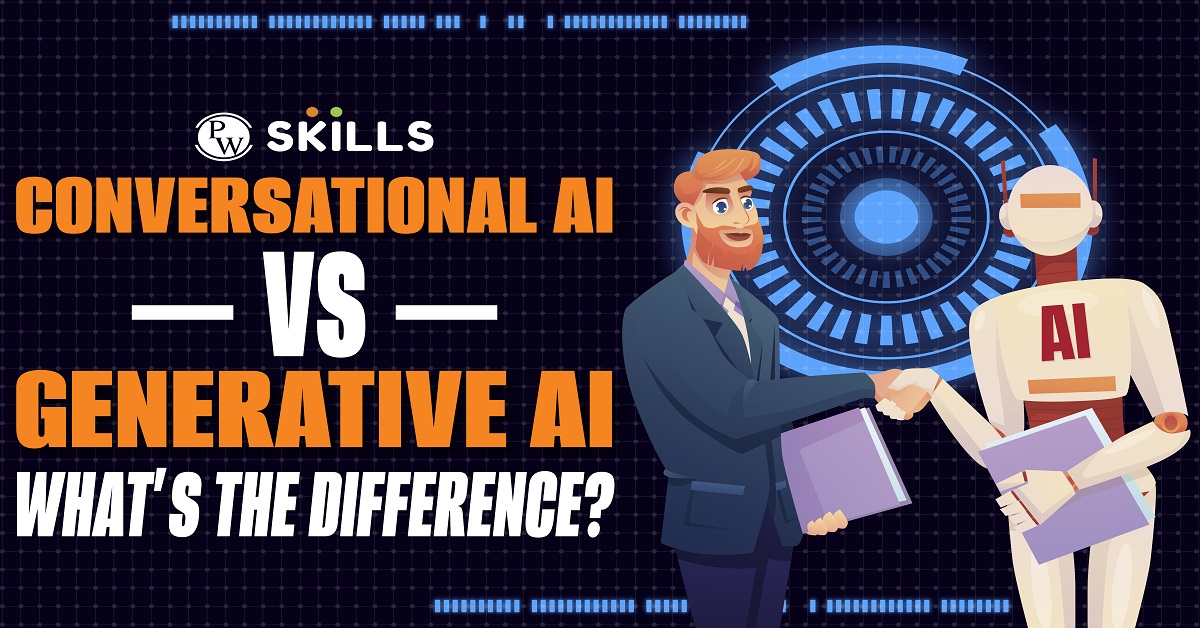Conversational AI VS. Generative AI: Are you curious about the emerging field of Artificial Intelligence (AI) and all its groundbreaking potential for businesses, government agencies and everyday people? Do you want to learn how conversational AI differs from generative AI so that you can better judge where these two areas overlap—and where they don’t? Your search is over; we’ve got the answer!
In this article, we’ll dive deep into the differences between Conversational AI and Generative AI so that you can make an informed decision on what technology best suits your needs.
The potential for conversational and generative AI in marketing, entertainment, education, and so many other areas is immense. It takes research and hard work to fully understand both technologies and confidently apply them.

For those interested in furthering their knowledge in Generative AIs, we recommend taking Data Science by Physics Wallah’s course – a comprehensive guide to Generative AIs. As an added benefit, all readers of this blog post using coupon code “READER” will get a special discount on this course.
Master Generative AI: Data Science Course by Physics Wallah offers a comprehensive guide to this cutting-edge technology. With detailed lectures from experts delivering actionable lessons and projects that go beyond the basics, it’s sure to take your understanding of generative AI beyond where you started today. So why wait – get learning now and master generative AI!
What is Conversational AI?
Conversational AI stands as a technology designed to facilitate more natural interactions and engagements between machines and humans. Its functionality mirrors a conversation, featuring a seamless exchange of communication.
Conversational AI applications span various platforms, including chatbots, messaging applications, and virtual assistants. Notable conversational AI instances include Alexa, Google Assistant, and Siri.
Also Read: What is Generative AI? Everything You Need to Know in 2024
What is Generative AI?
Generative AI represents the next frontier in artificial intelligence, characterized by its ability to generate novel content. Imagine having an AI friend with a penchant for storytelling. Instead of a human companion, you interact with this AI by giving it an initial prompt, such as ‘Once upon a time, in a galaxy far away.
The AI takes this starting point and crafts an entire space adventure narrative, weaving together characters, plot twists, and an enthralling conclusion. Generative AI can produce something entirely new based on the input it receives. It is a creative and imaginative companion, generating original content across various domains.
What sets Generative AI apart is its versatility. Contemporary generative AI models, like GPT-4 developed by OpenAI, extend beyond text generation to encompass images, music, and computer code. These models undergo training on extensive datasets, understanding underlying patterns. Subsequently, they leverage this knowledge to generate fresh data that aligns with the patterns observed during training.
Consider GPT-4 as a noteworthy illustration of generative AI capabilities. As a language prediction model, it has been trained on vast datasets from the internet. The output it generates closely resembles human-authored text, showcasing the remarkable potential of generative AI in replicating and creating content akin to that found in its training data.
Conversational AI VS. Generative AI – Working
Here is the working of both AI’s:
Conversational AI Working:
Conversational AI uses natural language processing (NLP) techniques and algorithms to engage in human-like conversations. Conversational AI systems analyze user inputs, typically text or voice commands, to understand the user’s intent and context. NLP algorithms recognize the user’s intent behind the input, determining the action or information the user seeks.
The AI generates appropriate responses based on the recognized intent and context. These responses can be pre-programmed, rule-based, or learned through machine learning. Conversational AI systems can adjust responses based on the user’s follow-up questions or statements, creating an interactive and dynamic conversational experience.
Also Read: What is Data Science?
Generative AI Working:
Generative AI is designed to create new content by learning patterns from a given dataset. Generative AI models are trained on large datasets relevant to the type of content they are expected to generate. For example, a text-based Generative AI model might be trained on a vast corpus of written text. The model learns the underlying patterns, structures, and styles present in the training data. This includes understanding syntax, semantics, and context.
When given a prompt or seed input, the Generative AI model generates new content that aligns with the learned patterns. This can include text, images, music, or other types of content.
Comparison:
- Conversational AI prioritizes dynamic interaction and understanding user intent in real-time conversations.
- Generative AI focuses on creativity and content creation, generating new outputs based on learned patterns from training data.
Also Read: What is Artificial Intelligence (AI)
Difference B/W Conversational AI VS. Generative AI
The table below provides a concise overview of the critical differences between Conversational AI and Generative AI, highlighting their distinct functionalities, outputs, and learning approaches.
| Conversational AI VS. Generative AI – Difference B/W Conversational AI VS. Generative AI | ||
| Criteria | Conversational AI | Generative AI |
| Primary Function | Engaging in real-time conversations with users | Creating new content based on learned patterns |
| Nature of Output | Text or voice responses in a conversation flow | Diverse outputs, including text, images, music, etc. |
| User Interaction | Interactive and dynamic, responding to user queries | Input-driven, generating content based on given prompts |
| Learning Approach | Understanding user intent, context, and maintaining dialogue | Learning patterns, structures, and styles from training data |
| Use Cases | Chatbots, virtual assistants, customer support applications | Text generation, image creation, creative content generation |
| Examples | Siri, Alexa, Google Assistant | GPT-3, DALL-E, ChatGPT |
| Training Data | Conversational data, FAQs, user interactions | Diverse datasets relevant to the type of content (text, images, etc.) |
| Adaptability | Adapts to dynamic user inputs and context changes | Versatile in generating various types of content based on input |
| Objective | Facilitating human-like conversations | Creating original and diverse content |
Conversational AI VS Generative AI Examples
These examples showcase well-known systems in Conversational AI and Generative AI, respectively. Conversational AI examples focus on virtual assistants and chatbots, while Generative AI examples demonstrate models capable of creating diverse content like text, images, and music.
| Conversational AI VS Generative AI Examples | |
| Conversational AI Examples | Generative AI Examples |
| Siri | GPT-3 |
| Google Assistant | DALL-E |
| Alexa | ChatGPT |
| Microsoft’s Xiaoice | OpenAI |
| IBM Watson Assistant | MuseNet |
Conversational AI vs Generative AI Python
Below is a table outlining some key aspects of Conversational AI and Generative AI in the context of Python:
| Conversational AI vs Generative AI Python | ||
| Feature | Conversational AI (Python) | Generative AI (Python) |
| Libraries/Frameworks | – NLTK (Natural Language Toolkit) | – TensorFlow |
| – ChatterBot | – PyTorch | |
| – Hugging Face Transformers (for GPT models) | ||
| – OpenAI API (for GPT-3 and similar models) | ||
| Platforms/APIs | – Rasa | – OpenAI API |
| – Dialogflow | – Hugging Face Model Hub | |
| Implementation | – User input processing | – Training models with large datasets |
| – Response generation | – Fine-tuning for domain-specific tasks | |
| – Integration with various platforms and channels | – Output generation for creative content (text, images, etc.) | |
| Use Cases | – Chatbots | – Text generation (stories, articles) |
| – Virtual Assistants | – Image creation and editing | |
| – Customer support bots | – Music composition and generation | |
| – Messaging applications | – Code generation | |
| – Creative content generation (poems, art) | ||
| Advantages | – Real-time interaction with users | – Creativity and content generation |
| – Effective for specific tasks (e.g., customer support) | – Versatility (multiple modalities: text, images, etc.) | |
| – Ability to create diverse and original content | ||
| Challenges | – Limited understanding of context | – Potential for biased or inappropriate outputs |
| – May struggle with nuanced or complex queries | – Resource-intensive training and fine-tuning | |
| – Dependency on pre-defined responses | – Ethical concerns (e.g., misuse of generated content) | |
Generative AI VS Machine Learning
Here’s a table outlining some key differences between Generative AI and Machine Learning:
| Generative AI VS Machine Learning | ||
| Feature | Generative AI | Machine Learning |
| Objective | Generates new, original content (text, images, etc.) | Learns patterns and relationships in existing data |
| Learning Approach | Unsupervised learning | Supervised, unsupervised, or reinforcement learning |
| Training Data | Trained on diverse datasets for creativity | Trained on labeled datasets for specific tasks |
| Output | Creates new content not explicitly in the training data | Predicts or classifies based on learned patterns |
| Examples | GPT models generating text, DALL-E creating images | Image classification, speech recognition, regression |
| Use Cases | Text and image generation, creative tasks | Classification, regression, pattern recognition |
| Flexibility | Can create content across various modalities | Task-specific, less versatile |
| Model Types | GANs, Transformers, VAEs | Decision trees, neural networks, support vector machines |
| Training Complexity | May require extensive training on diverse data | Depends on the complexity of the model and task |
| Resource Intensity | Training large models can be computationally expensive | Computational requirements depend on the model size |
| Interpretability | Outputs may lack clear interpretability | Models can provide insights into learned patterns |
| Common Libraries/Frameworks | OpenAI GPT, DALL-E, TensorFlow, PyTorch | Scikit-learn, TensorFlow, PyTorch, Keras |
| Real-time Interactivity | May have limitations due to computational complexity | Can be designed for real-time applications |
To help with mastering this technology, the course ‘Master Generative AI: Data Science Course’ by Physics Wallah is highly recommended as it covers all concepts related to generative AI and has tons of practical projects to gain hands-on experience.
Conversational AI VS. Generative AI FAQ's
Can Generative AI engage in conversations like Conversational AI?
Generative AI can produce human-like text and engage in conversations, but its primary strength is creating new content. While it can generate text responses, Conversational AI is specifically designed for dynamic interactions and is often more adept at understanding context and user intent.
What are some examples of Conversational AI applications?
Famous examples of Conversational AI include virtual assistants like Alexa, Google Assistant, and Siri, as well as chatbots integrated into websites, messaging apps, and customer service platforms.
Can Generative AI be used for text-based interactions only?
No, Generative AI is versatile and can create text, images, music, and code. For instance, OpenAI's GPT-4 is a language prediction model that can generate human-like text, showcasing the broad capabilities of Generative AI.
How are Conversational AI and Generative AI trained?
Conversational AI is trained on large datasets of human interactions, while Generative AI models are trained on specific datasets relevant to the type of content they are expected to generate.
Which technology is more suitable for customer support applications?
Conversational AI is often more suitable for customer support applications because it can understand user queries, provide predefined responses, and handle dynamic conversations. It is widely used in chatbots for customer service.





